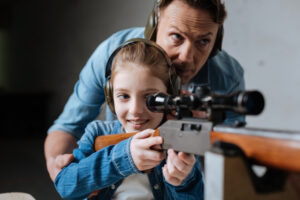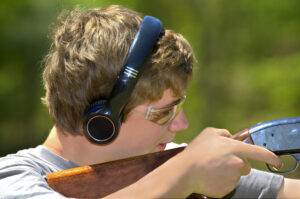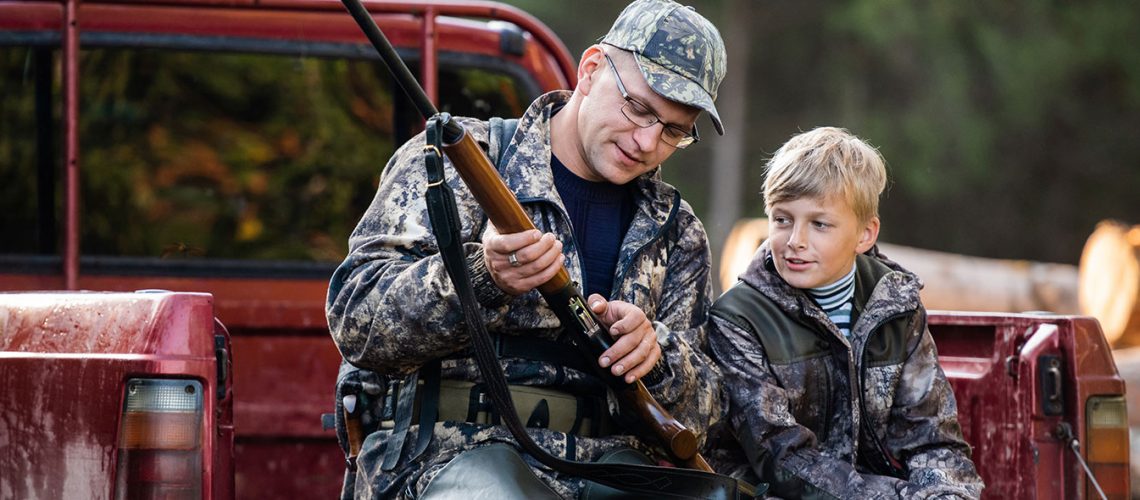The question of how to properly introduce firearms into the upbringing of a child weighs heavily on the minds of many parents. And, while there’s no universal answer, there are some practical, effective, and common sense rules of thumb. Here is a general timeline of a few.
Ages 3 to 6—Establishing Concepts. Just because a child may not be actually firing or handling a real firearm doesn’t mean the concepts can’t be established as early as they can comprehend.
There’s a difference between a toy gun and a real gun. That concept should be made clear, over and over again, in ways the child can understand. But there’s no reason the child can’t be taught to treat a toy gun the very same way they would a real one.
Why not have a gun safe or some semblance, for the toy guns—and require the child to follow every safety protocol and procedure a real firearm requires? It sets the tone for respect for firearms and begins to ingrain the fundamentals of gun handling and safety from the start.
 Ages 6 to 10—Strict Supervision After Demonstrated Learning. As the child matures, their interaction and appreciation of firearms must inevitably transition from the conceptual to the actual, real world. This will happen in several different areas.
Ages 6 to 10—Strict Supervision After Demonstrated Learning. As the child matures, their interaction and appreciation of firearms must inevitably transition from the conceptual to the actual, real world. This will happen in several different areas.
Teaching.
Even though a parent may choose to keep requiring their child to treat toy guys as if they are real in order to reinforce the rules of gun safety, a clear distinction must be made between the difference.
A child must be taught that a real firearm is capable of inflicting serious injury. That’s also why a child must be taught the difference between the make-believe guns on television and on video games.
Those guns are not actually injuring people. They’re representative and don’t really cause harm or damage in the real world. They are made for entertainment purposes, and have no binding repercussions in reality.
Depending on the child’s level of maturity and ability to process information emotionally, this is also the time that a child can learn what actually happens when someone is shot. So that they can begin to understand the reasons for gun safety procedures, and the consequences of shooting someone that can’t be taken back.
Planning.
Even children in homes without firearms should be taught the basics of gun safety for those occasions when they are around guns in another home. So, parents should plan to discuss how their child should behave should they encounter an unsupervised firearm.
A child should also be aware that there are places—most importantly his or her school—where firearms are NOT allowed. And in those instances, they should be taught the protocol of how to react if they see a firearm there.
Practice.
Finally, this is the age when a child who has demonstrated good behavior, reasoning, and self-control will likely be introduced to actually handling and interacting with firearms.
Cleaning firearms is a great way to get a child started. It teaches safety, demystifies handing the firearm, and fosters an understanding of how the firearm operates.
Under strict supervision, starting with a BB gun is also a good early step. Perhaps even an Airsoft gun. Definitely no recoil firearms. Teaching how to set-up, post, and take down a target can successfully impart the significance of knowing what’s behind what you’re shooting at. The rules of gun safety taught from the toy gun stage can now be put into actual practice.
Holding a child accountable for practicing the rules is also important. Until they learn to recall and perform all the rules properly, they shouldn’t begin shooting.
At around age nine—after a year of successful BB gun practice and experience—it could be time to progress to firing a .22. Under very strict adult supervision.
Reinforce the knowledge that a more powerful firearm carries with it more responsibility—and show them in visceral terms how the firearm can pass through various items like wood and metal.
Then reinforce the rules of gun safety, associating this more powerful firearm and explaining the “reasons why” with each rule.
 Age 10 And Up—A Progression Based On Demonstrated Responsibility. Responsibility and judgment are the benchmarks of the next steps in a child’s journey with firearms.
Age 10 And Up—A Progression Based On Demonstrated Responsibility. Responsibility and judgment are the benchmarks of the next steps in a child’s journey with firearms.
How much responsibility and judgment they show will determine how fast or how slow they progress on that journey.
Naturally, that means a child must constantly demonstrate the practice of good gun safety whether with a BB gun, a .22, and whether supervised or not.
This is the point at which the child should be developing the various attributes of marksmanship skill. Sight alignment, sight picture, breath control, trigger control, and follow through. They should also be developing pride in their mastery of that skill when it is evident.
If a child has demonstrated those traits, potential steps forward include coming along on a hunting trip—unarmed the first time out. Another step forward would be firing a handgun.

Responsibility & Nearing Adulthood—When Are Their Guns “Theirs”? At some point, your child will want to know when “their” firearms are really and truly “theirs”.
What they’re talking about is the unsupervised access to and use of firearms.
Just like driving a car, or numerous other things children must wait to do, their desire to have this unsupervised ability will be urgent.
As the parent, you’ll have to weigh their ability to handle this responsibility against their past behavior and current temperament.
Children under the age of 18 can’t buy a firearm, but in certain states, they can be given a gun by an adult with a parent’s permission. Of course, that ability can come with a catch, because parents are criminally liable in some states for gun activity by minors.
There are already laws in place regarding the sale of long guns to persons under the age of 18, and handguns to persons under 21 years of age. Those ages coincide with a child legally becoming an adult, of course, but before that time it’s the parent who can and should decide how much responsibility their child should have regarding firearms.
Some parents will decide that the amount is very little. Others will give their child much greater latitude.
It’s most likely better to err on the side of caution.
In the end, a child’s relationship with firearms is a lifelong lesson. It will chiefly be shaped by how your child sees you interacting with firearms.
And, this lifelong journey will be taken in small steps—each of them earned with responsibility and respect for the firearm, along with the rules surrounding it.
As you’ve probably already determined from reading this far, there are no hard and fast rules for progression along this timeline. The best measure will be the example of safety, procedure, and enjoyment you set for your child, and your child’s willingness to follow that example.

